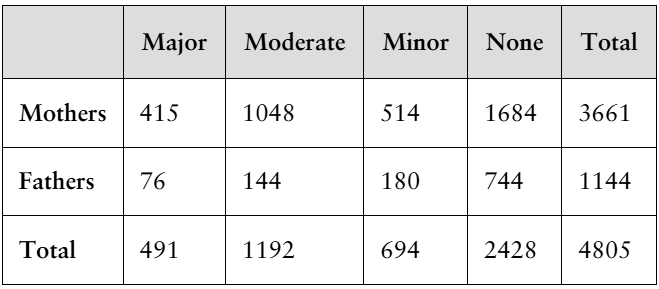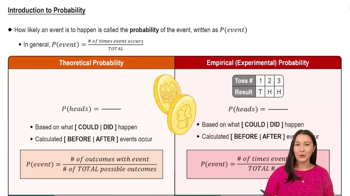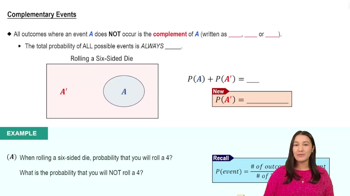13. Students A physics class has 40 students. Of these, 12 students are physics majors and 16 students are minoring in math. Of the physics majors, three are minoring in math. Find the probability that a randomly selected student is minoring in math or a physics major.
Table of contents
- 1. Intro to Stats and Collecting Data1h 14m
- 2. Describing Data with Tables and Graphs1h 55m
- 3. Describing Data Numerically2h 5m
- 4. Probability2h 16m
- 5. Binomial Distribution & Discrete Random Variables3h 6m
- 6. Normal Distribution and Continuous Random Variables2h 11m
- 7. Sampling Distributions & Confidence Intervals: Mean3h 23m
- Sampling Distribution of the Sample Mean and Central Limit Theorem19m
- Distribution of Sample Mean - Excel23m
- Introduction to Confidence Intervals15m
- Confidence Intervals for Population Mean1h 18m
- Determining the Minimum Sample Size Required12m
- Finding Probabilities and T Critical Values - Excel28m
- Confidence Intervals for Population Means - Excel25m
- 8. Sampling Distributions & Confidence Intervals: Proportion1h 12m
- 9. Hypothesis Testing for One Sample3h 29m
- 10. Hypothesis Testing for Two Samples4h 50m
- Two Proportions1h 13m
- Two Proportions Hypothesis Test - Excel28m
- Two Means - Unknown, Unequal Variance1h 3m
- Two Means - Unknown Variances Hypothesis Test - Excel12m
- Two Means - Unknown, Equal Variance15m
- Two Means - Unknown, Equal Variances Hypothesis Test - Excel9m
- Two Means - Known Variance12m
- Two Means - Sigma Known Hypothesis Test - Excel21m
- Two Means - Matched Pairs (Dependent Samples)42m
- Matched Pairs Hypothesis Test - Excel12m
- 11. Correlation1h 6m
- 12. Regression1h 50m
- 13. Chi-Square Tests & Goodness of Fit1h 57m
- 14. ANOVA1h 57m
4. Probability
Addition Rule
Problem 3.3.24c
Textbook Question
Mental Health A survey asks 4805 parents the severity of the mental issues they experienced from the coronavirus pandemic. The results are shown in the table. A parent is randomly selected from the sample. Find the probability of each event. (Adapted from Kaiser Family Foundation)

c. The parent did not have major mental health issues or is a mother.
 Verified step by step guidance
Verified step by step guidance1
Step 1: Understand the problem. We are tasked with finding the probability that a randomly selected parent either did not have major mental health issues or is a mother. This involves using the addition rule for probabilities and understanding the complement of 'major mental health issues.'
Step 2: Identify the relevant data. From the table, the total number of parents surveyed is 4805. The number of parents who did not have major mental health issues (i.e., those with moderate, minor, or none) is the sum of the values in the 'Moderate,' 'Minor,' and 'None' columns: 1192 + 694 + 2428 = 4314. The number of mothers surveyed is 3661.
Step 3: Use the addition rule for probabilities. The probability of event A (not having major mental health issues) or event B (being a mother) is calculated as P(A or B) = P(A) + P(B) - P(A and B).
Step 4: Calculate P(A), P(B), and P(A and B). P(A) is the probability of not having major mental health issues, which is 4314/4805. P(B) is the probability of being a mother, which is 3661/4805. P(A and B) is the probability of being a mother and not having major mental health issues, which is the sum of the 'Moderate,' 'Minor,' and 'None' values for mothers: (1048 + 514 + 1684)/4805.
Step 5: Substitute the values into the formula P(A or B) = P(A) + P(B) - P(A and B) to find the probability. Simplify the fractions and calculate the result.
 Verified video answer for a similar problem:
Verified video answer for a similar problem:This video solution was recommended by our tutors as helpful for the problem above
Video duration:
5mPlay a video:
Was this helpful?
Key Concepts
Here are the essential concepts you must grasp in order to answer the question correctly.
Probability
Probability is a measure of the likelihood that an event will occur, expressed as a number between 0 and 1. In this context, it involves calculating the chance of selecting a parent who either did not experience major mental health issues or is a mother. This can be determined by dividing the number of favorable outcomes by the total number of outcomes.
Recommended video:

Introduction to Probability
Complementary Events
Complementary events are two outcomes of an event that are mutually exclusive and collectively exhaustive. In this case, the event of a parent not having major mental health issues or being a mother can be analyzed by considering the complementary event, which is a parent having major mental health issues and being a father. Understanding complementary events helps in calculating probabilities more efficiently.
Recommended video:

Complementary Events
Conditional Probability
Conditional probability refers to the probability of an event occurring given that another event has already occurred. In this scenario, it may be useful to consider the conditional probabilities of being a mother or not having major mental health issues, as these factors can influence the overall probability calculation. This concept is essential for understanding how different conditions affect the likelihood of outcomes.
Recommended video:

Introduction to Probability

 5:14m
5:14mWatch next
Master Probability of Mutually Exclusive Events with a bite sized video explanation from Patrick
Start learningRelated Videos
Related Practice
Textbook Question
